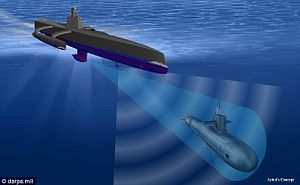Diesel-electric submarines are cheaper and quieter than their nuclear counterparts and they are rapidly being procured by states opposed to the national interests of the United States.
While not capable of traveling long distances or at great speed, diesel-electric submarines have the potential to deny the U.S. Navy access to strategic coastal areas and could also interrupt seaborne commerce. Equipped with air-independent propulsion systems and advanced lithium-ion batteries, the next generation of diesel-electric boats will even be harder to track down and destroy in the event of a naval conflict.
“Picking up the quiet hum of a battery-powered, diesel-electric submarine in busy coastal waters is like trying to identify the sound of a single car engine in the din of a major city,” Rear Admiral Frank Drennan, commander of the Naval Mine and Anti-Submarine Warfare Command, emphasized in March 2015.
Consequently, the United States military has been exploring options for some time now how to best counter this emerging asymmetrical threat.
Back in 2010, the U.S. Defense Advanced Research Projects Agency (DARPA), an agency responsible for developing emerging technologies for the military’s use, initiated a research project to develop an anti-submarine drone — a robot ship capable of tracking enemy subs in shallow waters.
The prototype of the U.S. Navy’s robot ship, the Anti-Submarine Warfare Continuous Trail Unmanned Vessel (ACTUV), is designed to operate autonomously for 60 to 90 days straight, surveil large stretches of ocean territory and — should an enemy sub be spotted — guide other U.S. naval assets to the vessel’s location to destroy it (the ACTUV itself is unarmed). The ACTUV prototype, named Sea Hunter, will be ready for extensive sea-trials in the fall of 2015, according to Defense One.
DARPA’s website outlines that the ACTUV’s “objective is to generate a vessel design that exceeds state-of-the art platform performance to provide propulsive overmatch against diesel electric submarines at a fraction of their size and cost.”
Furthermore, the ACTUV program is trying to fulfill the following requirements:
Advance unmanned maritime system autonomy to enable independently deploying systems capable of missions spanning thousands of kilometers of range and months of endurance under a sparse remote supervisory control model. This includes autonomous compliance with maritime laws and conventions for safe navigation, autonomous system management for operational reliability, and autonomous interactions with an intelligent adversary.
Autonomous compliance with maritime laws requires the correct identification of surface ships and other objects while at sea. DARPA is in the process of developing non-conventional sensor technologies for that purpose and issued a Request for Information (RFI) back in March 2015.
DARPA program manager Ellison Urban, quoted by Defense One, explains the rationale behind the U.S. Navy’s push for robot ships:
Instead of chasing down these submarines and trying to keep track of them with expensive nuclear powered-submarines, which is the way we do it now, we want to try and build this at significantly reduced cost. It will be able to transit by itself across thousands of kilometers of ocean and it can deploy for months at a time. It can go out, find a diesel-electric submarine, and just ping on it.

































